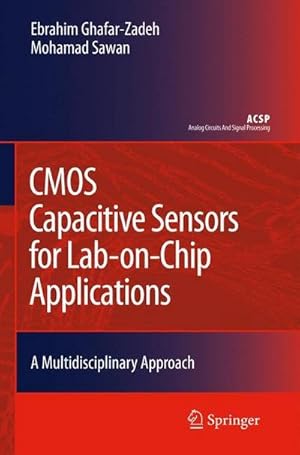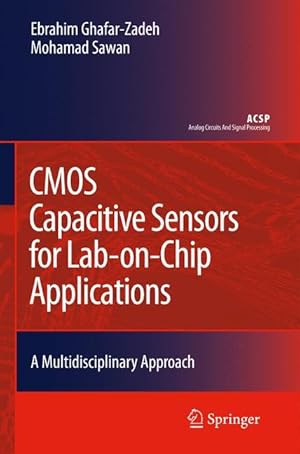9789400731806 - CMOS Capacitive Sensors for Lab-on-Chip Applications: A Multidisciplinary Approach de Ghafar-Zadeh, Ebrahim; Sawan, Mohamad (10 résultats)
Filtres de recherche
Type d'article
- Tous les types de produits
- Livres (10)
- Magazines & Périodiques (Aucun autre résultat ne correspond à ces critères)
- Bandes dessinées (Aucun autre résultat ne correspond à ces critères)
- Partitions de musique (Aucun autre résultat ne correspond à ces critères)
- Art, Affiches et Gravures (Aucun autre résultat ne correspond à ces critères)
- Photographies (Aucun autre résultat ne correspond à ces critères)
- Cartes (Aucun autre résultat ne correspond à ces critères)
- Manuscrits & Papiers anciens (Aucun autre résultat ne correspond à ces critères)
Etat En savoir plus
- Neuf (9)
- Comme neuf, Très bon ou Bon (Aucun autre résultat ne correspond à ces critères)
- Assez bon ou satisfaisant (Aucun autre résultat ne correspond à ces critères)
- Moyen ou mauvais (Aucun autre résultat ne correspond à ces critères)
- Conformément à la description (1)
Reliure
- Toutes
- Couverture rigide (Aucun autre résultat ne correspond à ces critères)
- Couverture souple (10)
Particularités
- Ed. originale (Aucun autre résultat ne correspond à ces critères)
- Signé (Aucun autre résultat ne correspond à ces critères)
- Jaquette (Aucun autre résultat ne correspond à ces critères)
- Avec images (5)
- Sans impressions à la demande (7)
Langue (1)
Livraison gratuite
Pays
Evaluation du vendeur
-
CMOS Capacitive Sensors for Lab-on-Chip Applications. A Multidisciplinary Approach.
Edité par Dordrecht, Springer Netherland., 2012
ISBN 10 : 9400731809 ISBN 13 : 9789400731806
Langue: anglais
Vendeur : Universitätsbuchhandlung Herta Hold GmbH, Berlin, Allemagne
EUR 16
EUR 30 expédition depuis Allemagne vers Etats-UnisQuantité disponible : 1 disponible(s)
Ajouter au panier2010. 16 x 24 cm. X, 146 S. X, 146 p. softcover Versand aus Deutschland / We dispatch from Germany via Air Mail. Einband bestoßen, daher Mängelexemplar gestempelt, sonst sehr guter Zustand. Imperfect copy due to slightly bumped cover, apart from this in very good condition. Stamped. (Analog Circuits and Signal Processing). Sprache: Englisch.
-
CMOS Capacitive Sensors for Lab-on-Chip Applications: A Multidisciplinary Approach (Analog Circuits and Signal Processing)
Vendeur : Lucky's Textbooks, Dallas, TX, Etats-Unis
EUR 103,10
EUR 3,44 expédition vers Etats-UnisQuantité disponible : Plus de 20 disponibles
Ajouter au panierEtat : New.
-
CMOS Capacitive Sensors for Lab-on-Chip Applications: A Multidisciplinary Approach (Analog Circuits and Signal Processing)
Vendeur : California Books, Miami, FL, Etats-Unis
EUR 127,92
Gratuit expédition vers Etats-UnisQuantité disponible : Plus de 20 disponibles
Ajouter au panierEtat : New.
-
CMOS Capacitive Sensors for Lab-on-Chip Applications: A Multidisciplinary Approach (Analog Circuits and Signal Processing)
Vendeur : Ria Christie Collections, Uxbridge, Royaume-Uni
EUR 121,64
EUR 13,59 expédition depuis Royaume-Uni vers Etats-UnisQuantité disponible : Plus de 20 disponibles
Ajouter au panierEtat : New. In.
-
CMOS Capacitive Sensors for Lab-on-Chip Applications: A Multidisciplinary Approach
Vendeur : Revaluation Books, Exeter, Royaume-Uni
EUR 150,51
EUR 11,34 expédition depuis Royaume-Uni vers Etats-UnisQuantité disponible : 2 disponible(s)
Ajouter au panierPaperback. Etat : Brand New. 2010 edition. 156 pages. 9.25x6.10x0.36 inches. In Stock.
-
CMOS Capacitive Sensors for Lab-on-Chip Applications | A Multidisciplinary Approach
Vendeur : preigu, Osnabrück, Allemagne
EUR 95,80
EUR 70 expédition depuis Allemagne vers Etats-UnisQuantité disponible : 5 disponible(s)
Ajouter au panierTaschenbuch. Etat : Neu. CMOS Capacitive Sensors for Lab-on-Chip Applications | A Multidisciplinary Approach | Mohamad Sawan (u. a.) | Taschenbuch | x | Englisch | 2012 | Springer | EAN 9789400731806 | Verantwortliche Person für die EU: Springer Verlag GmbH, Tiergartenstr. 17, 69121 Heidelberg, juergen[dot]hartmann[at]springer[dot]com | Anbieter: preigu.
-
CMOS Capacitive Sensors for Lab-on-Chip Applications : A Multidisciplinary Approach
Edité par Springer Netherlands, Springer Netherlands, 2012
ISBN 10 : 9400731809 ISBN 13 : 9789400731806
Langue: anglais
Vendeur : AHA-BUCH GmbH, Einbeck, Allemagne
EUR 111,35
EUR 61,24 expédition depuis Allemagne vers Etats-UnisQuantité disponible : 1 disponible(s)
Ajouter au panierTaschenbuch. Etat : Neu. Druck auf Anfrage Neuware - Printed after ordering - 1.1 Overview of Lab-on-Chip Laboratory-on-Chip (LoC) is a multidisciplinary approach used for the miniaturization, integration and automation of biological assays or procedures in analytical chemistry [1-3]. Biology and chemistry are experimental sciences that are continuing to evolve and develop new protocols. Each protocol offers step-by-step laboratory instructions, lists of the necessary equipments and required biological and/or chemical substances [4-7]. A biological or chemical laboratory contains various pieces of equipment used for performing such protocols and, as shown in Fig. 1.1, the engineering aspect of LoC design is aiming to embed all these components in a single chip for single-purpose applications. 1.1.1 Main Objectives of LoC Systems Several clear advantages of this technology over conventional approaches, including portability, full automation, ease of operation, low sample consumption and fast assays time, make LoC suitable for many applications including. 1.1.1.1 Highly Throughput Screening To conduct an experiment, a researcher fills a well with the required biological or chemical analytes and keeps the sample in an incubator for some time to allowing the sample to react properly. Afterwards, any changes can be observed using a microscope. In order to quickly conduct millions of biochemical or pharmacolo- cal tests, the researchers will require an automated highly throughput screening (HTS) [8], comprised of a large array of wells, liquid handling devices (e.g., mic- channel, micropump and microvalves [9-11]), a fully controllable incubator and an integrated sensor array, along with the appropriate readout system.
-
CMOS Capacitive Sensors for Lab-on-Chip Applications
Edité par Springer Netherlands Mai 2012, 2012
ISBN 10 : 9400731809 ISBN 13 : 9789400731806
Langue: anglais
Vendeur : BuchWeltWeit Ludwig Meier e.K., Bergisch Gladbach, Allemagne
EUR 106,99
EUR 23 expédition depuis Allemagne vers Etats-UnisQuantité disponible : 2 disponible(s)
Ajouter au panierTaschenbuch. Etat : Neu. This item is printed on demand - it takes 3-4 days longer - Neuware -1.1 Overview of Lab-on-Chip Laboratory-on-Chip (LoC) is a multidisciplinary approach used for the miniaturization, integration and automation of biological assays or procedures in analytical chemistry [1-3]. Biology and chemistry are experimental sciences that are continuing to evolve and develop new protocols. Each protocol offers step-by-step laboratory instructions, lists of the necessary equipments and required biological and/or chemical substances [4-7]. A biological or chemical laboratory contains various pieces of equipment used for performing such protocols and, as shown in Fig. 1.1, the engineering aspect of LoC design is aiming to embed all these components in a single chip for single-purpose applications. 1.1.1 Main Objectives of LoC Systems Several clear advantages of this technology over conventional approaches, including portability, full automation, ease of operation, low sample consumption and fast assays time, make LoC suitable for many applications including. 1.1.1.1 Highly Throughput Screening To conduct an experiment, a researcher fills a well with the required biological or chemical analytes and keeps the sample in an incubator for some time to allowing the sample to react properly. Afterwards, any changes can be observed using a microscope. In order to quickly conduct millions of biochemical or pharmacolo- cal tests, the researchers will require an automated highly throughput screening (HTS) [8], comprised of a large array of wells, liquid handling devices (e.g., mic- channel, micropump and microvalves [9-11]), a fully controllable incubator and an integrated sensor array, along with the appropriate readout system. 156 pp. Englisch.
-
CMOS Capacitive Sensors for Lab-on-Chip Applications
Vendeur : moluna, Greven, Allemagne
EUR 92,27
EUR 48,99 expédition depuis Allemagne vers Etats-UnisQuantité disponible : Plus de 20 disponibles
Ajouter au panierEtat : New. Dieser Artikel ist ein Print on Demand Artikel und wird nach Ihrer Bestellung fuer Sie gedruckt. This unique multidisciplinary book describes all the required components for the design of a CMOS capacitive biosensorIt offers an extensive recent review of literature on using CMOS processes for Lab-on-Chip applicationsIt emphasis on prac.
-
CMOS Capacitive Sensors for Lab-on-Chip Applications
Edité par Springer Netherlands, Springer Netherlands Mai 2012, 2012
ISBN 10 : 9400731809 ISBN 13 : 9789400731806
Langue: anglais
Vendeur : buchversandmimpf2000, Emtmannsberg, BAYE, Allemagne
EUR 106,99
EUR 60 expédition depuis Allemagne vers Etats-UnisQuantité disponible : 1 disponible(s)
Ajouter au panierTaschenbuch. Etat : Neu. This item is printed on demand - Print on Demand Titel. Neuware -1.1 Overview of Lab-on-Chip Laboratory-on-Chip (LoC) is a multidisciplinary approach used for the miniaturization, integration and automation of biological assays or procedures in analytical chemistry [1¿3]. Biology and chemistry are experimental sciences that are continuing to evolve and develop new protocols. Each protocol offers step-by-step laboratory instructions, lists of the necessary equipments and required biological and/or chemical substances [4¿7]. A biological or chemical laboratory contains various pieces of equipment used for performing such protocols and, as shown in Fig. 1.1, the engineering aspect of LoC design is aiming to embed all these components in a single chip for single-purpose applications. 1.1.1 Main Objectives of LoC Systems Several clear advantages of this technology over conventional approaches, including portability, full automation, ease of operation, low sample consumption and fast assays time, make LoC suitable for many applications including. 1.1.1.1 Highly Throughput Screening To conduct an experiment, a researcher fills a well with the required biological or chemical analytes and keeps the sample in an incubator for some time to allowing the sample to react properly. Afterwards, any changes can be observed using a microscope. In order to quickly conduct millions of biochemical or pharmacolo- cal tests, the researchers will require an automated highly throughput screening (HTS) [8], comprised of a large array of wells, liquid handling devices (e.g., mic- channel, micropump and microvalves [9¿11]), a fully controllable incubator and an integrated sensor array, along with the appropriate readout system.Springer Verlag GmbH, Tiergartenstr. 17, 69121 Heidelberg 156 pp. Englisch.







